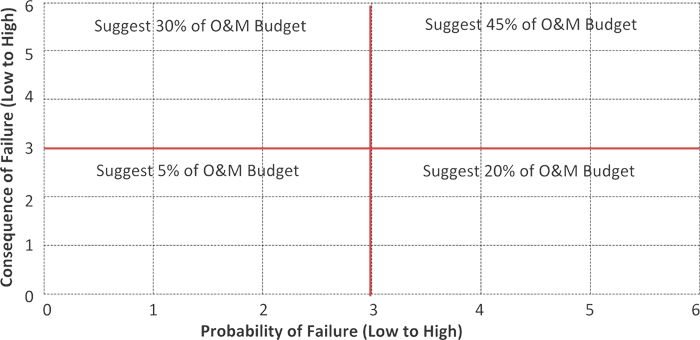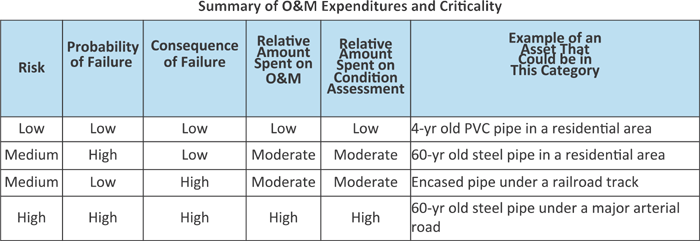All operations and maintenance activities and monitoring require time and money, which are finite resources, particularly at a small utility. Therefore, it is extremely important that a utility carefully consider the following questions:
Once a utility decides to move to more planned maintenance, the next question is which maintenance activities should be performed and how often. Just as reactionary maintenance is more expensive than planned maintenance, doing the wrong type or frequency of planned maintenance is also inefficient and wastes money. Furthermore, doing inappropriate activities takes time away from doing the activities that are most likely to prevent failures. For example, although the oil in a car could be replaced every month, doing so does not extend its life more than changing the oil every 3 months or changing the oil based on usage.
The question of which maintenance to perform and how often relates to the discussion of criticality in Chapter 5. he more critical an asset is, the more important preventative maintenance is. If an asset is likely to fail and the consequence is high if it does fail (the high criticality box on the quad chart,) then a utility would be wise to put a lot of resources and effort into making sure the failure doesn't occur. If, on the other hand, an asset is unlikely to fail and even if it does, the consequences are very low, the utility shouldn't be spending much on trying to prevent the failure. In fact, in the case of low criticality assets, letting the asset "run to failure" may be the most advantageous way to operate. This concept will be explained in more detail in Section 6.4.
Examining the assets that are in the high criticality category is a good starting point for deciding what maintenance to perform. Each class and type of asset has different types of maintenance that can help prevent a failure. A cleaning program can help prevent sewer pipe failures. A flushing and inspection program can help prevent fire hydrant failures. A valve exercising program can help prevent valve failure. A pump cleaning program can help prevent chemical feed pump failures. The first step is to determine the types of assets in the high risk category and the types of maintenance that can be performed to help forestall the failure. The next step is to determine if the utility has the tools and expertise to perform the maintenance. If it is not possible to perform maintenance to forestall a failure, another option, such as replacement, rehabilitation or providing a redundant asset to reduce the risk may be chosen.
As with operational procedures, maintenance activities need to be documented in some way. There are several options. A utility could have a written program, a generic computer-based program, or a computerized maintenance management system (CMMS.) EPA's CUPSS program includes a maintenance component to help small utilities identify routine maintenance activities. Any type of written or electronic maintenance program needs to include a mechanism to document that the work has been completed, so that managers can track maintenance activities and cost on an individual asset basis.
For most utilities, prior to initiating an Asset Management program, maintenance is usually spread out relatively evenly across assets. Following Asset Management principles changes this spread of maintenance tasks to one that is much more heavily oriented towards high risk assets. The criticality quad chart in Chapter 5 can be used to show how maintenance expenditures should be distributed across the four boxes. Most of the expenditures should be in the high risk box and very little should be in the low risk box. A quad chart showing a potential split of maintenance tasks by criticality is presented below.

The following table summarizes the information regarding expenditures on O&M and related expenditures for condition assessment or monitoring.

Similar to maintenance expenditures, expenditures on condition assessment and monitoring should match risk. The greater the risk, the more worthwhile expenditures on condition assessment or monitoring. There is very little value in monitoring the condition of assets that have little risk of failure, particularly when the utility will probably take no action to prevent these failures.
Maintenance activities are an important part of preventing asset failures. However, it is never possible, even with the best maintenance program, to prevent all failures. At some point, the asset may have deteriorated or aged to the point that it is no longer feasible to forestall failure; or continued maintenance may be so expensive relative to the cost of a new asset that maintenance may no longer be the best option. In these cases, the asset should be replaced or rehabilitated through the capital improvement plan.
- What maintenance am I currently doing that I need to continue?
- What maintenance am I currently doing that I need to discontinue?
- What maintenance am I not doing that I need to start doing?
- What maintenance am I not doing that should stay that way?
Once a utility decides to move to more planned maintenance, the next question is which maintenance activities should be performed and how often. Just as reactionary maintenance is more expensive than planned maintenance, doing the wrong type or frequency of planned maintenance is also inefficient and wastes money. Furthermore, doing inappropriate activities takes time away from doing the activities that are most likely to prevent failures. For example, although the oil in a car could be replaced every month, doing so does not extend its life more than changing the oil every 3 months or changing the oil based on usage.
The question of which maintenance to perform and how often relates to the discussion of criticality in Chapter 5. he more critical an asset is, the more important preventative maintenance is. If an asset is likely to fail and the consequence is high if it does fail (the high criticality box on the quad chart,) then a utility would be wise to put a lot of resources and effort into making sure the failure doesn't occur. If, on the other hand, an asset is unlikely to fail and even if it does, the consequences are very low, the utility shouldn't be spending much on trying to prevent the failure. In fact, in the case of low criticality assets, letting the asset "run to failure" may be the most advantageous way to operate. This concept will be explained in more detail in Section 6.4.
Examining the assets that are in the high criticality category is a good starting point for deciding what maintenance to perform. Each class and type of asset has different types of maintenance that can help prevent a failure. A cleaning program can help prevent sewer pipe failures. A flushing and inspection program can help prevent fire hydrant failures. A valve exercising program can help prevent valve failure. A pump cleaning program can help prevent chemical feed pump failures. The first step is to determine the types of assets in the high risk category and the types of maintenance that can be performed to help forestall the failure. The next step is to determine if the utility has the tools and expertise to perform the maintenance. If it is not possible to perform maintenance to forestall a failure, another option, such as replacement, rehabilitation or providing a redundant asset to reduce the risk may be chosen.
As with operational procedures, maintenance activities need to be documented in some way. There are several options. A utility could have a written program, a generic computer-based program, or a computerized maintenance management system (CMMS.) EPA's CUPSS program includes a maintenance component to help small utilities identify routine maintenance activities. Any type of written or electronic maintenance program needs to include a mechanism to document that the work has been completed, so that managers can track maintenance activities and cost on an individual asset basis.
For most utilities, prior to initiating an Asset Management program, maintenance is usually spread out relatively evenly across assets. Following Asset Management principles changes this spread of maintenance tasks to one that is much more heavily oriented towards high risk assets. The criticality quad chart in Chapter 5 can be used to show how maintenance expenditures should be distributed across the four boxes. Most of the expenditures should be in the high risk box and very little should be in the low risk box. A quad chart showing a potential split of maintenance tasks by criticality is presented below.
Relationship Between Probability of Failure and Consequence of Failure

The following table summarizes the information regarding expenditures on O&M and related expenditures for condition assessment or monitoring.

Similar to maintenance expenditures, expenditures on condition assessment and monitoring should match risk. The greater the risk, the more worthwhile expenditures on condition assessment or monitoring. There is very little value in monitoring the condition of assets that have little risk of failure, particularly when the utility will probably take no action to prevent these failures.
Maintenance activities are an important part of preventing asset failures. However, it is never possible, even with the best maintenance program, to prevent all failures. At some point, the asset may have deteriorated or aged to the point that it is no longer feasible to forestall failure; or continued maintenance may be so expensive relative to the cost of a new asset that maintenance may no longer be the best option. In these cases, the asset should be replaced or rehabilitated through the capital improvement plan.

